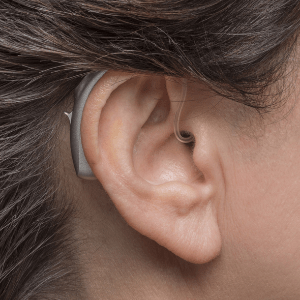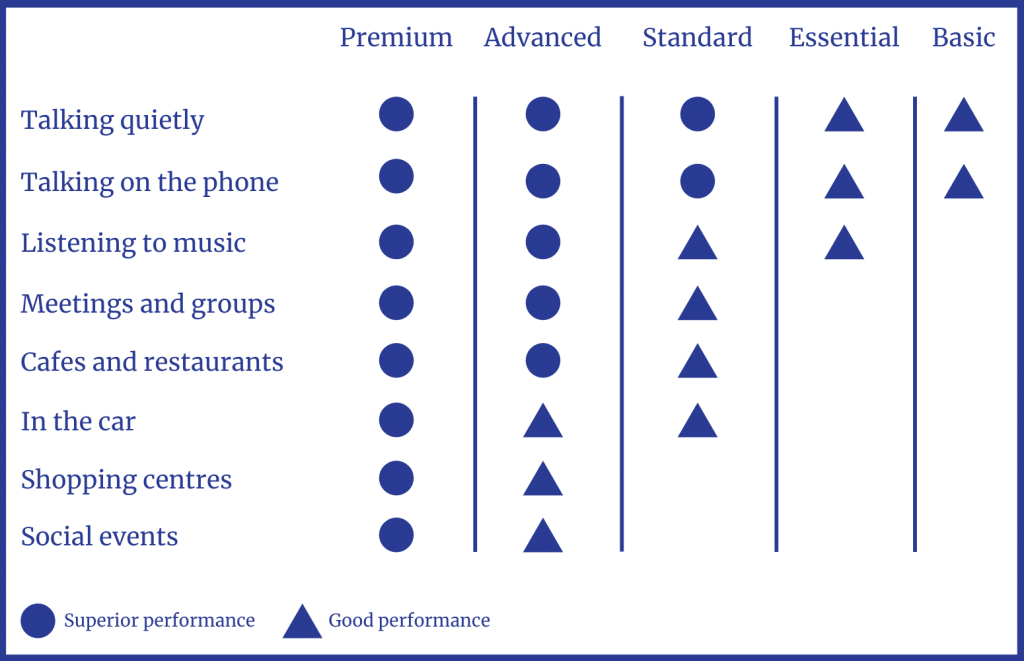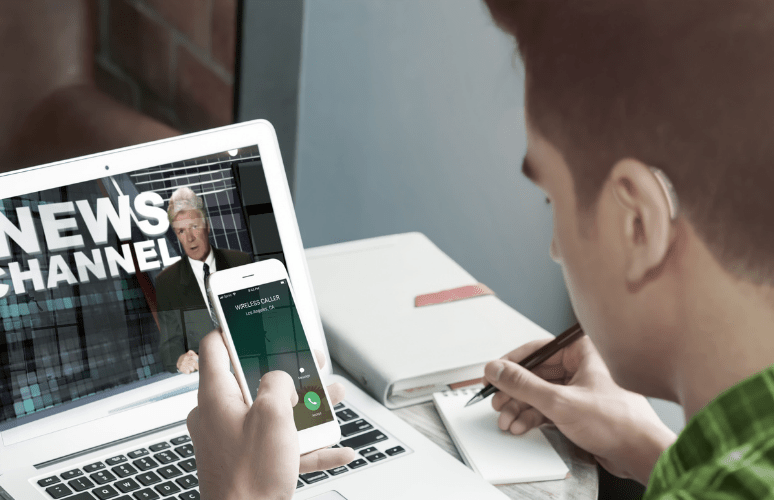Discreet hearing aid designed to fit completely in your ear.

Neurosensory supports the broadest range of hearing aids to suit your individual needs, lifestyle and budget.
Take them home for a trial, with no upfront payment or commitment.
Neurosensory supports one of the broadest ranges of hearing aid brands and types of devices.
This means we can recommend the best-fit solution to maximise your hearing gains without compromise.
We don’t pay our audiologists sales commissions like other clinics.
You will not be pressured into a more expensive brand/ product just to hit a sales quota.
Experience aids in your own environment.
Take them home for a trial, with no upfront payment or commitment.
We stand behind all the services we deliver and devices we fit.
If you have any concerns we will do our utmost to remedy the situation. We also offer a 60 day return/ exchange period.
We provide the option for simple monthly interest free repayment plans.
Benefit from your hearing aids sooner, taking some pressure off your budget.
Eligible Pension and DVA recipients have access to free testing services and hearing aid products as part of the Hearing Services Program.
Neurosensory is an approved provider in this program.
What is a hearing aid trial?
This is an opportunity for you to experience wearing the latest aids for 1 week in your own environment. The purpose is to determine if you will gain benefit in the situations where you are having difficulty hearing. These might include conversations at home, family gatherings, meetings, clubs, work or watching TV.
There are no strings attached; it is free and there is no obligation to make a purchase at the end.

I thought the trial was very worthwhile. I was amazed by the technology and also how comfortable they felt. I could hardly feel them in my ears and my kids didn’t even notice them.
Although they helped me a lot with the TV and at work, I don’t think I am quite ready to make the leap yet and my Audiologist was fine with this. I have an appointment in a year to review my hearing. All in all, a great experience.
Peter (Accountant)
I was very nervous about hearing aids particularly as my mother didn’t have much success with them. However, during the trial I was amazed at how easy they were to manage and the incredible difference they made to my life. I could finally converse with ease and didn’t have to turn the TV volume up.
I realised hearing aids had come a long way in the last 10 years and I was very comfortable in proceeding with them after the trial. The audiologist discussed the different options and how each would fit into my lifestyle. The hearing aids that were fitted have given me a new lease on life.
Jenny (Retiree)
There are a number of different brands of hearing aids and each have their strengths and weaknesses. Some manufacturers specialise in hearing aids for people with a severe loss whilst others have perfected the art of making discreet invisible devices. Other manufacturers produce aids that are ideally suited to adults with a noise induced hearing loss.
At Neurosensory, our experienced audiologists can recommend the aids that are best suited to your unique needs, budget and lifestyle.
We recognise that this is an important decision, and to remove the risk, we provide you with a 60 day period to either exchange your hearing aids, or return them altogether.

A hearing aid is not just a sound amplifier but a highly sophisticated device similar to a powerful computer.
It has 3 basic components: a microphone, a loudspeaker and a processor (computer chip).
The microphone picks up the sound and transmits it to the processor. The processor amplifies and modifies the sound (eg. removing some of the background noise) and transmits it to the loudspeaker where it is sent into the ear.
The processor is programmed by the audiologist to suit your hearing loss and needs. It performs many functions beyond amplifying the signal including automatic volume regulation, noise reduction and feedback suppression. So there is no longer a need to fiddle with a volume control or put up with annoying whistling sounds.
Discreet hearing aid designed to fit completely in your ear. The most popular type of hearing aid are in the ear hearing aids. An ear piece (virtually unnoticeable) sits behind the ear and a small soft tip sits inside the ear canal without blocking it, making for very discreet hearing aids. A behind the ear hearing aid hooks over the top of the ear and rests behind the ear. A tube connects the hearing aid to a custom ear piece that fits in the ear canal. Some have a ‘slim tube’ which is quite discreet.
Custom

Receiver in the canal (RIC)

Behind the ear hearing aid
The cost of aids vary by level. The aids we offer are available at 5 levels – Basic, Essential, Standard, Advanced and Premium.
All the aids work well for conversation in quiet, talking on the phone, and listening to music. In addition, the majority, with exception of the basic level, will connect to mobile phones for hands-free calls and listening to music/podcasts, have a compatible app and the option of a rechargeable battery.
High end aids have more features and perform better in noisy, complex listening situations such as in cafes, restaurants, shopping centres and at social events.

The best hearing aid for you will depend on your hearing loss and goals, needs, lifestyle and budget. Your Audiologist will make recommendations based on all of these factors.
If you are having trouble with your hearing, here are 5 reasons as to why you should do something about it.
Forget the big beige ear huggers with the large silicon moulds from yester-year. Todays hearing aids come in many styles; all are sleek, discrete and unobtrusive.
Modern hearing aids are easy – pop them in and forget them. Just enjoy the benefits of engaging with the world again. There is no need to change batteries as they can be rechargeable. There is no need to fiddle with the volume control or change programs because they automatically adjust depending on the listening environment you are in.
New hearing aid wearers are amazed at how comfortable modern hearing aids feel. Most aren’t even aware that they are wearing them. For the majority of adults, the part in the ear consists of a small comfortable, virtually invisible dome.
In the past hearing aids often whistled which was embarrassing for the wearer and annoying for family and friends. Feedback suppression technology means that this is no longer an issue for hearing aid wears.
Modern hearing aids are much more discreet and advanced. They stream calls from your phone directly to both ears along with music, podcasts, audio books and face-time calls. There is no need to fiddle with batteries – they are rechargeable! They have really neat apps and a range of accessories that will amaze your friends and family.
Modern hearing aids are mini computers – They focus on sounds coming from different directions, cut out noise, and automatically adapt to the situation the speaker is in by turning on different listening features and microphones.

Connect directly to your mobile phone
Modern hearing aids allow hands-free phone and video calls. The phone signal is streamed directly to both hearing aids providing clarity and ease of use. Music, podcasts, radio, TV and audiobooks can also be streamed.
Improved performance in noisy situations
Modern hearing aids are mini computers – They provide clear speech and improved hearing in noisy environments using sophisticated noise reduction technology. In addition, they automatically adapt to the situation the speaker is in by turning on different listening features and microphones.
Most people with a hearing loss obtain benefit from modern hearing aids. For your peace of mind we offer a 1 week, obligation free hearing aid trial. During this period you can wear the hearing aids in your own environment to determine first hand if you gain benefit in situations where you are having difficulty hearing.
At Neurosensory, we fit all brands, technology levels and types of devices. This means your audiologist can recommend the best hearing aid/s to meet your needs, based on your hearing loss, lifestyle, budget and personal preferences.
Receiver in the Ear (RIC)
This is strongly recommended as there are many benefits of wearing a hearing aid for each ear including improved hearing in noisy situations, ability to tell the direction of a sound, greater ease of listening and a richer more natural sound.
The latest hearing aids are designed for comfort. After a couple of weeks most people barely notice that they are wearing them.
Hearing aids are designed to be very discreet. The majority of people you come into contact with will not notice you are wearing them.
Yes! Many hearing aids connect directly to smartphones. This means you can use them for hand-free calls and can even stream music, e-books and podcasts directly to your hearing aids.
Yes, at Neurosensory you can take them home for a trial with no upfront payment or commitment.
Early studies suggest that hearing aids may help prevent cognitive decline in people suffering from hearing loss.
Eligible Pension and DVA recipients have access to free-to-client hearing assessments and hearing aids/devices as part of the Australian Hearing Services Program. Neurosensory is an approved provider in the Program.
Your audiologist will program the hearing aids to fit your degree and type of hearing loss. This means that the level of amplification and sound processing will provide optimal sound and the volume will never be loud enough to do harm.
For the majority of people hearing aids will make tinnitus (ringing sounds in the ear) less noticeable.
Most hearing aids have an app that allows you to adjust the volume and settings to personalise your listening experience.
Hearing aids are like glasses. They will help you enjoy life more and you will wonder how you managed without them.
There is a short adjustment period particularly if it has been a long time since you last heard the full range of sounds. At the first fit, the audiologist will set the hearing aids at a conservative level to ensure you are comfortable.
Batteries last between 3 and 7 days depending on the type of hearing aid. However, many hearing aids now use rechargeable batteries.
The life of a hearing aid is approximately 5 to 6 years.
Hearing aids have sophisticated noise reduction technology designed to tune out background noise so listening in challenging situations will be easier. However, you are still likely to experience some difficulty as even people with normal hearing struggle in these environments.
Hearing aids come in a vast array of colours to select from.
At Neurosensory you have peace of mind with a 60 day return or exchange period.
Hearing aids will make sounds and conversation easier to hear but will not reverse damage to the ear.
Advancements in hearing aid technology require a huge amount of research and development. In fact, each hearing aid contains a tiny processor (computer chip) and works like a mini computer.
This was an issue with older hearing aid and was caused from sound leaking out of the ear canal and being fed back into the hearing aid microphone. Modern hearing aids have sophisticated noise cancelling technology and should not whistle.
The major hearing aid manufacturers are based in Switzerland, Germany, Denmark and USA.